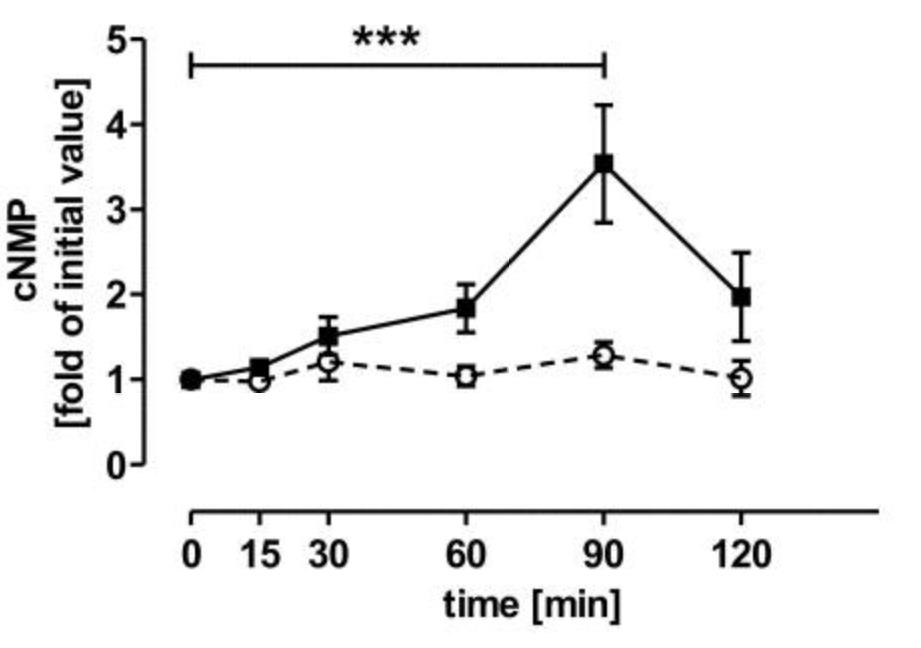Blood Partitioning Analysis Service
Creative Biolabs has built an efficient platform to offer blood partitioning analysis services in ADME. Through our advanced technological platform, every customer can enjoy high-quality and efficient services.
HPLC-MS/MS in Analysis
HPLC-MS/MS can be used for analysis of various sample types and compound categories, including drugs, biomarkers, environmental samples, etc. HPLC-MS/MS systems often have automation capabilities, enabling high-throughput sample processing and data analysis, and enhancing experimental reproducibility and accuracy.
 Fig.1 Analysis of cNMP of C. elegans using HPLC-MS/MS.1
Fig.1 Analysis of cNMP of C. elegans using HPLC-MS/MS.1
The HPLC-MS/MS can detect compounds at very low concentrations, making it an ideal tool for drug analysis and biological sample analysis. Through multiple reaction monitoring (MRM) modes, HPLC-MS/MS can accurately identify and quantify target molecules, reducing interference from other substances. HPLC-MS/MS provides high-resolution mass spectrometry data, aiding in the accurate identification of compound structures and molecular weights.
In summary, the advantages of HPLC-MS/MS include:
-
Wide applicability
-
High level of automation
-
Rapid analysis
-
High sensitivity, selectivity, and resolution
Blood Partitioning Analysis by HPLC-MS/MS
We measured the distribution of drug compounds between red blood cells (RBC) and plasma using the HPLC-MS/MS method and obtained the RBC-to-plasma ratio (KRBC/PL). In the past, RBC distribution was typically assessed by measuring drug levels in equilibrated plasma as well as in whole blood or RBC, which involved the creation of separate standards in these specific matrices. The conventional approach to determining RBC partitioning was demanding in terms of labor and challenging to streamline for automation. Compared to traditional methods, HPLC-MS/MS offers faster analysis speeds, improving experimental efficiency. The HPLC-MS/MS method was validated using commercial compounds and showed a good correlation with literature values. It was also compared to the traditional method for measuring RBC partitioning of proprietary compounds, yielding equivalent results.
When we analyze blood partitioning by HPLC-MS/MS, the steps typically include the following:
-
Prepare the sample with appropriate pre-treatment, such as protein precipitation, dissolution, dilution, etc., for subsequent analysis.
-
Introduce the prepared sample into the liquid chromatography system through an autosampler.
-
Separate the compounds in the sample using the liquid chromatography system, typically employing different mobile phases and columns for separation.
-
Ionize and analyze the separated compounds using the mass spectrometer, usually generating ions in the ion source and analyzing them in the mass spectrometer.
-
Process and analyze the obtained mass spectrometry data using data processing software, including peak identification, quantitative analysis, etc. At last, identify and quantify the compounds based on the analysis results, generating the final analysis report.

In particular, the characteristics of blood partitioning analysis by HPLC-MS/MS include:
-
Only necessary to measure the compound concentration in a single matrix
-
No need to prepare calibration standards
-
Suitable for high-throughput screening
You might be interested in these ADME-related services: High-Throughput ADME, Kinetic Solubility Testing, and Thermodynamic Solubility Testing. Please feel free to contact us at any time.
Reference
-
Beckert, U., et al. " The Receptor-Bound Guanylyl Cyclase DAF-11 Is the Mediator of Hydrogen Peroxide-Induced cGMP Increase in Caenorhabditis elegans" International journal of cell biology 8.8 (2013): e72569.
For Research Use Only | Not For Clinical Use


 Fig.1 Analysis of cNMP of C. elegans using HPLC-MS/MS.1
Fig.1 Analysis of cNMP of C. elegans using HPLC-MS/MS.1

 Download our brochure
Download our brochure